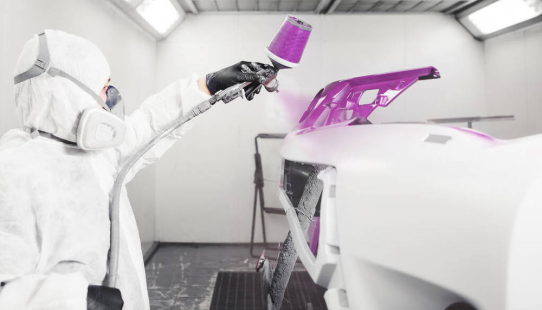Address:Room 906, building 6, SIIC Center, No.195 Hong Kong East Road, Laoshan District, Qingdao city, Shandong Province, China
E-mail:info@deltachem.net
ØTrends in automotive coatings:
Automotive coatings are developing in the direction of environmental protection and improving the appearance and decorative effect of the whole car, there are a variety of environmental protection certification of the product will be preferred. The limitation of VOC has become an important indicator of automotive coatings, and if water-based coatings are used, the VOC emissions of the whole vehicle can be reduced by more than half!
ØPainted structures of automobiles
Take passenger vehicles as an example:
Base material → phosphating layer → primer → medium coating → base color paint → overcoat paint

ØWhat are the applications of PU coatings in the automotive industry?
>> Polyurethane coatings for automotive parts and interior and exterior finishes
Automobile parts, interior and exterior decorative parts are diverse, and the performance requirements for coatings are also different.
For example, bumpers use acrylic polyurethane (PU) coatings;
Polyurethane (PU) primer used for fenders, side guards and under bumper guards;
Polyurethane (PU) coatings used for wheel covers, spoilers, and door handles;
2K polyurethane (PU) coatings used for automobile interiors by the Austrian company vianova resins, among others.
>> Polyurethane Coatings for Car Body
Primer
The vast majority of automotive primers use cathodic electrophoretic paints. Cathodic electrophoresis PU coatings can be prepared by using closed type polyurethane (PU), polyester resin, epoxy resin, etc.. Nowadays, in the process of going waterborne, the first step towards waterborne primer can greatly reduce VOC emissions, and Nissan was the first to start the 3C1B process using waterborne primer in 2010, and used two-component urethane as a clear coat to meet the requirements for appearance. Honda, on the other hand, uses a solvent-based, two-component polyurethane mid-coat primer in the 3C1B process for waterborne primer to improve the system's resistance to stone strikes. It is reported that the waterborne basecoat has also begun to be waterborne, and both Toyota and General Motors (GM) have begun to use the waterborne 3C1B process. The waterborne 3C1B process using two-component polyurethane clearcoats has become the standard in GM's future global process planning.
Polyurethane (PU) electrophoretic coatings include the following three main categories: waterborne polyurethane (PU) resin electrophoretic paints, polyurethane (PU) modified waterborne resin electrophoretic paints, and waterborne closed polyisocyanate. Among them, waterborne closed polyisocyanate is most commonly used as a crosslinking agent for various electrophoretic paints.
Medium Coating Paint
Polyurethane (PU) paint (including a variety of modified polyurethane paint) varieties, applications are also very wide, to adapt to the environmental requirements of waterborne polyurethane (PU) paint also has a very good performance, especially flexibility and impact resistance is better than solvent-based coatings. Anti-stoning and cold resistance of polyurethane (PU) paint is one of the development direction of automobile paint.
Top Coat
Hyundai Motor Company (Hyundai) launched a sporty "i-mode" sedan. The new car attracted the attention of consumers as soon as it was introduced. The most appreciated feature is the innovative polyurethane coating that has the ability to heal itself, self-repairing scratches on the car, and is extremely resistant to abrasion. Plastic surfaces are protected by polyurethane coatings and give the material surfaces a luxurious look and a delicate feel.
Refinish Paint
Waterborne two-component polyurethane coatings for automotive refinish paints usually add additives such as leveling agents, defoamers, catalysts, light stabilizers, thickeners, and organic co-solvents to the hydroxyl-containing components, and then adjust the viscosity with water after mixing with the polyisocyanate component, and then use the spray method to construct the coatings.
ØHow to obtain the high quality Automotive water-based PU coating?
By selecting the right UV absorbers, light stabilizers and antioxidants to be added to PU waterborne paints, the long-term weathering resistance of the paint can be significantly improved, and the gloss of the coating can be maintained, avoiding surface cracking and spotting. In addition, it also prevents the peeling of the automotive paint surface, enabling the paint to provide better protection.
OMNISTAB solutions for water-based PU coating:
OMNISTAB AN1130 can be applied to both solvent-borne and water-borne coatings, and in addition to automotive coatings, is also widely used in wood coating.
OMNISTAB UV400 is a kind of high-end triazine UV absorber, it shows high thermal stability andperformance for coatings exposed to high bake cycles and/orextreme environmental conditions.
OMNISTAB LS292 is a general HALS widely used in both water-based and solvent-based coating.
OMNISTAB LS123 is a NOR-type HALS, which shows weak alkalinity. It can avoid the reaction with acid components in coatings, and provide better stability.
OMNISTAB AN6133 is suitable for solvent-based PU coating, it's no phenol, low volatile and Eco-friendly.
OMNISTAB HN130 is water-based and especially suitable for eco-friendly PU coatings.